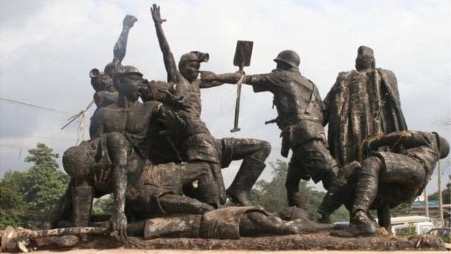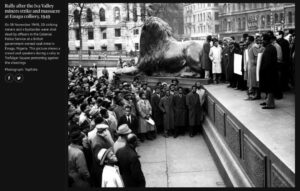IVA VALLEY BOOKS sells a good range of socialist, economics and environmental books (new and fairly used). We are on the 2nd Floor of Labour House (NLC Offices) in central Area- Abuja.
We are usually open from 9am to 4pm each weekday. We now also have a good selection of e-books which cost only around N500 to N1,000 and many pamphlets that only cost N200.
More details are available from Lekan on 07037163465
Iva Valley Massacre, 70 Years Later

The killing of 21 striking coalminers on November 18, 1949, at the Iva Valley mines Enugu, was a turning point in the struggle against colonialism. Working-class people’s resistance spurred anti-colonial revolts, ascertaining the leading role of the working class as the strongest and most consistent social force in fighting for a better society. There are several lessons to learn from this heroic moment in the history of the working class.
The colonialists presented British imperialism as a defender of “democracy” during World War II, since it was part of the allies that routed fascism on the European continent. Workers sacrificed, increasing productivity, including in the coalmines, to support the war campaign. But after the end of the war, cost of living skyrocketed making life harder for workers and democracy was stifled with colonial dictatorship still very much in place. This sparked off the 1945 Cost of Living Allowance (COLA) General Strike.

To contain the rising anger, the colonial administration instituted some reforms meant to incorporate trade unions while encouraging workers to work harder with little added benefits. In the coalmines, as in many other places, this did not work. The miners had forged solidarity with coalminers in Britain during the war, drawing inspiration from the latter’s earlier victory. More importantly, the Colliery Workers Union (CWU), one of the two unions formed by coalminers in 1941 (the other being the Colliery Surface Improvement Union) was built with a radical spirit of rank and file activism.
When the Trade Union Ordinance was passed in 1938 making unionism legal, this was considered a “the surest way to securing industrial stability and the removal of extremist tendencies” by the colonial administrators. To secure this aim, the conservative British Trade Union Congress was co-opted, sending in industrial relations experts to help mould Nigerian unionists into moderate and “reasonable” “social partners” of the state. Such missions were not very successful. The relationship between the trade union movement and the radical wing of the nationalist movement blossomed. As in most major cities, Enugu was a hotbed of collaboration between radical trade unionists and the nationalists.
By 1943, the real wages of workers was nothing to write home about as a result of inflation. It was as high as 150% in Lagos, while in Enugu it was 75%. The CWU demanded a significant pay rise in August 1944 to offset this. They were also emboldened by the victory of the British coalminers who had won wage increases and reduction in working hours through a massive strike. Management refused to budge to the workers’ demands.
When they threatened to go on strike, management invoked the General Defence Regulation of 1942 which prohibited strikes as part of the constructed “unity” needed to win the war, instituting greater managerial control over the work processes in the mines. This was partly with the intention of weakening unionism. The unions resisted this, but management still utilised the law to ensure compulsory arbitration where it was ruled as being in order, in January 1945. The workers’ refused to be cowed by this ruling and were all summarily sacked with 1,800 new workers recruited.
Due to the skills required for work in the mines, quite a number of the “new” workers were amongst those sacked. These even included union activists, such as Okwudili Ojiyi, the CWU Chair, whom management grudgingly reemployed because of their sound expertise on the job that the bosses saw as necessary for boosting productivity at a critical point in time. However, union recognition was withdrawn.
This did not dampen the morale of the workforce. They rather became creative. They commenced a “go-slow” strike which technically speaking was not a strike and they could thus not be found culpable of violating the anti-workers’ regulations. They sustained this throughout the year. By the last quarter of 1945, output of coal which was 155,664 tons at the beginning of the year had plunged to 16,546 tons.
In January 1946, a second phase of the road leading to the 1949 final conflict unfolded. European managers, had been granted a £5 underground allowance, while the African coalminers’ longstanding demands for increment remained unheeded to. Speaking for the miners, Ojiyi pointed out that this was a case of “grim discrimination”.
He also argued that the banning of the union and sacking of workers a year earlier was also in violation of the colonial labour regulations as it had been executed with a lockout, voicing the popular position of the workers for the formal reinstatement of their union. By February, the workers, once again commenced a “go-slow” strike, describing this as going “ca ‘canny”, drawing from the narrative of coalminers in Durham, Britain, during the strike wave there, where to “go ca ’canny” meant “work to rule”.
The “ca ‘canny” was not very successful. But the workers were not deterred. In November 1947, the workers went “ca ‘canny” for the same demands. This time around, they won and even arrears from January 1946 summing up to more than £150,000 for various categories of workers was granted. The union was reinstated and an anti-worker system of “rostering” for work, which amounted to casualization of labour was prohibited in the Collective Agreement reached.
But behind its “surrender” to unionisation, management had other plans. The lifting of the ban was to be part of a processes that was meant to split the unions (particularly CWU) into four branches with the aim of separating the most radical leaders from the mass of underground workers. To rub insult upon injury, despite a long drawn process of negotiations on the procedures for implementing the 1947 Collective Agreement, management restored “rostering”. This was the straw that broke the camel’s back.
All the attempts by the union executives to make management respect the Collective Agreement’s provision against the casualization of “rostering”, were rebuffed. On November 8, “hewers” who were underground rank and file workers and most affected went on a “wild cat” go slow strike. In an attempt to smash the strike, management sacked 50 of them. This deepened the resistance. “Tub men” joined the “hewers”. The regional government situated in Enugu commenced recruitment of new workers. Remembering the lockout of 1945, the miners occupied the mines.
The colonialists were frightened. This was also the period when the radical nationalist Zikist Movement declared its Call to Revolution, through “positive action”. The government decided to move out explosives from the mines. 900 policemen were brought to the mines from outside Enugu to effect this. The workers were initially reluctant, believing this was the first step of the bosses towards a lockout. But eventually, they allowed this the police to move out the explosives.
It was within this context, with miners coming out in their hundreds from the underground shaft with red clothes tied to their helmets and arms as they sang solidarity songs in Igbo, that a Captain F. S. Phillips ordered the shooting, claiming that they brandished “weapons – bows, arrows, machetes, long steel bars”. It has been established beyond all reasonable doubts that this statement of his was a blatant lie. The men bore no such arms. Their arms were their conviction, unity, solidarity and labour power.
Phillips not only ordered the shooting. The first miner shot down was Sunday Anyasado with a bullet in the mouth from Phillips’ revolver. Livinus Okechukwuma followed him, also killed by Phillips. As the murderous intent of the state dawned on the striking miners they fled, but even this was not enough for the shameless killers in uniform. At least six of the twenty one miners killed were shot in the back.
The entire country exploded in response. A National Emergency Committee was constituted by trade unions and nationalist groups which mobilised resources to support the miners and their families. For many Nigerians it was a clear demonstration of the need for self-government. The colonial administration tried to quell the situation by immediately constituting a 4-person commission of inquiry led by Judge W. J. Fitzgerald. By the time the commission would be wrapping up its work, there had been a swing in the balance of forces in favour of reaction.
In February 1950, the Zikist National Vanguard, which inspired leading activists in the Iva Valley mines attempted to assassinate Sir Hugh Foot. Repression followed and this dovetailed into recommendations of the Fitzgerald’s commission. Leaders of the workers were scapegoated for the strike, jailed and banned from the mines after their release.
There are several lessons to inspire us today from this long drawn struggle which lifted a valley to the heights of a mountain of struggle. It shows that the primary site of our struggle as workers is the workplace. A single branch can inspire the deepening of struggle across the nation. The coalminers never gave up. Standing for years on their demands, they won an agreement after 3 years, including with arrears. But we also can see that the bosses will never give up. When they have the opportunity they roll back gains of years of struggle.
This is exactly why our struggle must not be limited to the piecemeal improvements we can win and do win sometimes. We must fight to defeat the bosses, uniting our different streams of resistance into an ocean of revolution whose tidal waves can smash their system of exploitation. Only thus can we win our emancipation, as workers. This focus should run through our minds as the compass for the many battles we fight, and together, we will one day win this class war, bringing to birth a new world on the ashes of the old.
Originally published by Socialist Worker, November 27, 2015
For more background information see: https://wessexsolidarity.wordpress.com/mal-contents-rants/the-iva-valley-colliers/
